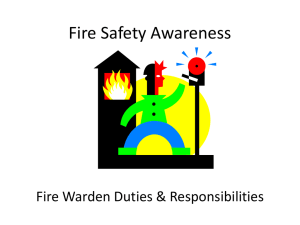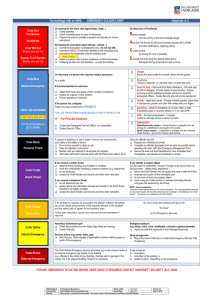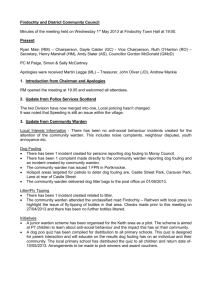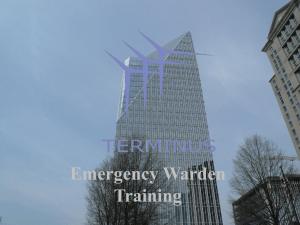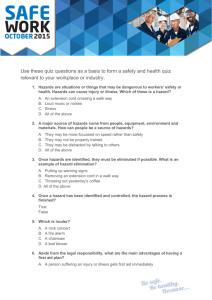CBE Emergency plan (OCX, 830KB) - Australian National University
advertisement
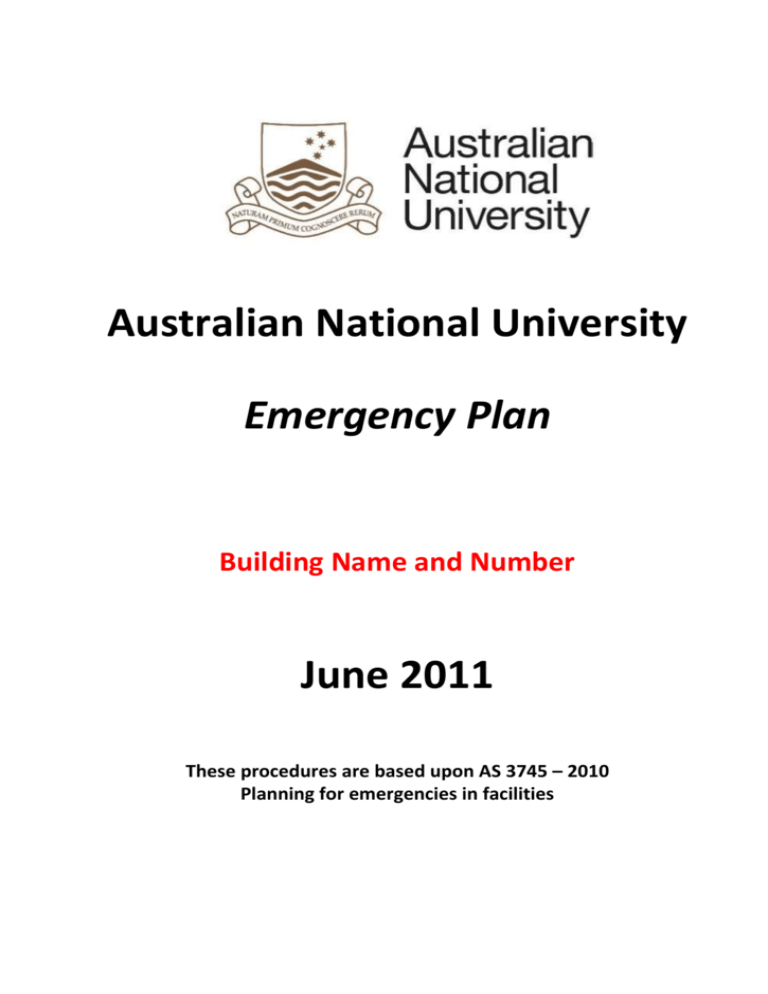
Australian National University Emergency Plan Building Name and Number June 2011 These procedures are based upon AS 3745 – 2010 Planning for emergencies in facilities EMERGENCIES For life threatening emergencies dial From an internal phone dial 0-000 ANU Security can be reached by dialling 612 52249 Press 1 for emergencies Press 2 for all other enquires EMERGENCY PLAN 2 of 16 Date: June 2011 Version: 3.0 1.0 2.0 2.1. 2.2. 2.3. 3.0 3.1 3.2. 3.3. 4.0 4.1 4.2 4.3 5.0 6.0 6.1 6.2 6.3 6.4 6.5 6.6 6.7 Table of Contents Purpose .............................................................................................................................. 4 Emergency Planning Committee (EPC) .................................................................................... 4 Responsibilities .................................................................................................................... 4 Members ............................................................................................................................ 5 Meetings ............................................................................................................................. 5 EMERGENCY CONTROL ORGANISATION (ECO) ......................................................................... 6 PRIMARY ROLES AND DUTIES................................................................................................. 7 Hierarchy and identification .................................................................................................. 9 Resources required by members of the ECO Team ................................................................... 9 Emergency Identification .................................................................................................... 10 Rating the risk of an emergency ........................................................................................... 11 Evacuation Exercises........................................................................................................... 14 Evacuation Procedures ....................................................................................................... 14 General Safety Requirements .............................................................................................. 14 General Building Information............................................................................................... 15 Building Familiarity ............................................................................................................. 15 Emergency Exits ................................................................................................................. 15 Emergency Lighting ............................................................................................................ 15 Air Conditioning ................................................................................................................. 15 Fire Safety Systems & Equipment ......................................................................................... 15 Fire Alarm ......................................................................................................................... 15 Fire Fighting Equipment ...................................................................................................... 16 EMERGENCY PLAN 3 of 16 Date: June 2011 Version: 3.0 1.0 Purpose This Emergency Plan sets out procedures to be followed in the event of an emergency. A building emergency can develop for a number of causes: fire, bomb threat, earthquake, structural fault, leakage of gas or chemical and others. The Emergency Plan provides the structure and directions that will prevent injury to staff, students, clients, visitors and premises in the event of an emergency. The Emergency Plan considers any special processes undertaken in buildings (e.g. laboratory activities, computer operations, research materials, etc.) and provides shut down processes in the event of an emergency. 2.0 Emergency Planning Committee (EPC) An emergency planning committee (EPC) shall be formed for each facility by the person or persons responsible for the facility, its occupants and visitors. Depending on the nature of the particular facility (ies), the EPC may be formed either for an individual facility or group of facilities. The EPC shall be appropriate for the particular facility (ies). Those responsible for a facility or its occupants shall ensure that the EPC has adequate resources to enable the development and implementation of the emergency plan. 2.1. Responsibilities The EPC shall be responsible for development, implementation and maintenance of the emergency plan, emergency response procedure and related training in collaboration with building custodians, occupiers and ANU Fire Safety Officer. The duties of the EPC shall be read in conjunction with ANU Emergency Response procedure. The duties of the EPC shall include the following but not limited to: a) Identifying events that could reasonably produce emergency situations; b) Ensuring that resources are provided to enable the development and implementation of the emergency plan; c) Ensuring that the emergency plan is readily identifiable and available to the appropriate persons; d) Establishing an emergency control organization (ECO) to operate in accordance with the emergency plan; e) Implementation of the emergency plan. The following shall apply to the implementation process: I. Awareness of the emergency response procedures; II. Training; III. Testing the emergency procedures; and IV. Review of procedures. f) Establishing arrangements to ensure the continuing operation of the ECO. g) Ensuring that the register of ECO members is current and readily available. h) Ensuring that the emergency response procedures remain viable and effective by reviewing, and testing the emergency response procedures at least annually. i) Ensuring that the emergency plan is reviewed at the end of the validity period, after an emergency, an exercise, or any changes that affect the emergency plan. j) Ensuring that a permanent record of events for each emergency is compiled and retained. k) Identifying and rectifying deficiencies and opportunities for improvement in the emergency plan and emergency response procedures. Members of staff, students, visitors, contractors shall follow the reasonable directions form any ECO member. EMERGENCY PLAN 4 of 16 Date: June 2011 Version: 3.0 2.2. Members The EPC shall consist of not less than two people who shall be representative of the stakeholders in a facility one of which shall be management. The representative from management might include the following: Director Building custodian Chief fire warden or ANU fire safety officer At least one member of the EPC shall be a competent person (A person who has acquired through training, education, qualification, experience or a combination of these, the knowledge and skill enabling him/ her to correctly perform the required task). 2.3. Meetings The EPC shall meet at least annually. A record of EPC meetings shall be made and retained. EMERGENCY PLAN 5 of 16 Date: June 2011 Version: 3.0 3.0 EMERGENCY CONTROL ORGANISATION (ECO) An Emergency Control Organisation (ECO) is a structured organisation of persons to organise and supervise the safe movement of occupants of a building or a group of buildings in an emergency. At The Australian National University, the ECO can consist of the following roles Building Chief Warden Deputy Building Chief Warden Communications Officer Building Floor Wardens Building Wardens Safety Officers First Aid Officers (Security after hours will act as Building Chief Wardens). Responsibilities, authorities and duties The Emergency Control Organisation (ECO) has been established to deal with all emergency incidents that may affect the safety and wellbeing of staff, students and members of the public on campus. The specific roles for each position are detailed in this section. Members of the ECO are required to control crowds and implement an appropriate response provided the ECO emergency response procedures are followed. Responsibilities of the Emergency Control Organisation The Emergency Control Organisation is comprised of several members (as listed above, depending upon the size of facility) drawn from the occupants of the building. The responsibilities of the ECO during an emergency are to: Conduct an orderly evacuation of the building’s occupants, including members of the public who may be in the building at the time, to a safe place of assembly Assist the Emergency Services Operate portable fire fighting equipment if trained to do so as long as it is safe to do so. IT SHOULD BE CLEARLY UNDERSTOOD THAT THE PRIMARY DUTY OF WARDENS IS NOT TO COMBAT EMERGENCIES BUT TO ENSURE, AS FAR AS PRACTICABLE, THE SAFETY OF STAFF, STUDENTS & MEMBERS OF THE PUBLIC AND THEIR ORDERLY EVACUATION FROM THE BUILDING EMERGENCY PLAN 6 of 16 Date: June 2011 Version: 3.0 3.1 PRIMARY ROLES AND DUTIES The primary roles and duties of ECO members are listed below: A: Pre-Emergency a) Building Chief Warden Maintain a current register of ECO members; Replace ECO members when a position becomes vacant; Organise regular exercises; Ensure the emergency response procedures are kept up to date; Attend meetings of the EPC, as appropriate; and Ensure personal ECO identification is available. b) Communications Officer Ensure personal proficiency in operation of the facility communications equipment; Maintain records and logbooks and make them available for emergency response; Ensure that ECO members are proficient in use of the facility communications equipment; and Attend training and emergency exercises, as required by the EPC. c) Floor/area warden: Confirm sufficient wardens for area of responsibility; Coordinate the completion of Personnel Emergency evacuation Plan (PEEP) documentation for person with disability; Report on deficiencies of emergency equipment; Ensure that wardens have communicated the emergency response procedures to all occupants within their nominated areas; Ensure that occupants are aware of the identity of their wardens; Coordinate safety practices (e.g., clear egress paths, access to first-attack equipment and disposal of rubbish) by wardens throughout their area of responsibility; and Attend training and emergency exercises, as required by the EPC. d) Wardens: Ensure that all occupants are aware of the emergency response procedures; Carry out safety practices (e.g., clear egress paths, access to first-attack Equipment and disposal of rubbish); Ensure personal ECO identification is available; and Attend training and emergency exercises, as required by the EPC. e) Emergency response team ERT (if applicable): Attend regular training; Practise use of specialized equipment (e.g. SCBA); Maintain specialised equipment as per manufacturers’ specifications; Ensure that personal protective equipment is maintained and available; Ensure personal ERT identification is available; Pre-emergency planning; and Attend training and emergency exercises, as required by the EPC. EMERGENCY PLAN 7 of 16 Date: June 2011 Version: 3.0 B: Emergency In case of Emergency ensure ANU Security 52249 has been called by building chief warden or relevant authorized person. The actions to be undertaken by the ECO in the event of an emergency shall include, but not be limited to, the following: a) Building Chief warden: On becoming aware of an emergency, the chief warden shall take the following actions: Respond and take control, as appropriate; Ascertain the nature of the emergency and implement appropriate action; Ensure that the appropriate Emergency Service has been notified; Ensure that floor or area wardens are advised of the situation, as appropriate; If necessary, after evaluation of the situation and using all of the information and resources available, initiate an action plan in accordance with the emergency response procedures and control entry to the affected areas; Brief the Emergency Services personnel upon arrival on type, scope and location of the emergency and the status of the evacuation and, thereafter, act on the senior officer’s instructions; and Any other actions as considered to be necessary or as directed by Emergency Services. b) Deputy Building Chief Warden: The deputy building chief warden shall assume the responsibilities normally carried out by the building chief warden if the building chief warden is unavailable, and otherwise assist as required. c) Communications officer: The communications officer, on becoming aware of the emergency, shall take the following actions: Ascertain the nature and location of the emergency; Confirm that the appropriate Emergency Service has been notified; Notify appropriate ECO members; Transmit instructions and information; Record a log of the events that occurred during the emergency; and Act as directed by the chief warden. d) Floor/area wardens: On hearing an alarm or on becoming aware of an emergency, the floor or area wardens shall take the following actions: Implement the emergency response procedures for their floor or area; Ensure that the appropriate Emergency Service has been notified; Direct wardens to check the floor or area for any abnormal situation; Commence evacuation if the circumstances on their floor or area; Communicate with the chief warden by whatever means available and act on instructions; Advise the chief warden as soon as possible of the circumstances and action taken Assist occupants with special needs; Co-opt persons as required to assist a warden during an emergency; and Confirm that the activities of wardens have been completed and report this to the chief warden or a senior officer of the attending Emergency Services if the Chief Warden is not contactable. EMERGENCY PLAN 8 of 16 Date: June 2011 Version: 3.0 e) Emergency response team: Members of the emergency response team shall carry out activities as set out in the emergency response procedures and the following: Respond to the emergency as directed by the chief warden; Communicate the status of the situation with the chief warden; and Hand over to and brief Emergency Services on arrival. C: Post-Emergency The actions to be undertaken by the ECO after an emergency should include, but not be limited to, the following: a) Building Chief warden: When the emergency incident is rendered safe or the Emergency Service returns control, notify the ECO members to have occupants return to their facility, as appropriate; Organize a debrief with ECO members and, where appropriate, with any attending Emergency Service; Compile a report for the EPC, management, ANU fire safety and OHS; and Lodge a University incident report via HORUS. b) Communications officer: Collate records of events during the emergency for the debrief; and Ensure they are secured for future reference. c) Floor/area wardens: Report of the actions taken during the emergency for the debrief. d) Emergency response team: Clean and service used specialised equipment; and Replace specialized equipment as necessary. NOTE: The re-entry and post emergency actions should be done in collaboration with the facility owners, managers, occupiers and employers. 3.2. Hierarchy and identification The control of emergencies will be greatly assisted if key personnel can be quickly identified by staff, students, visitors and officers of all emergency services. Wearers Title Building Chief Warden or Deputy Floor Warden / Area Warden Warden Communication Officer Helmet / cap colour White Yellow Red White First Aid Officer Green 3.3. Resources required by members of the ECO Team 1. 2. Helmet, caps, hats, vest or Tabards with wearers identification Floor plan of building identifying the following features: Location of exits; Location of fire fighting equipment; Location of Warden Intercommunication Phones (WIP); Location of Fire Panel (FIP); Location of Emergency Warning and Intercommunication Panel (EWIS); and Evacuation assembly areas. 3. 003 Key to open the OWS / EWS / EWIS panel if installed EMERGENCY PLAN 9 of 16 Date: June 2011 Version: 3.0 4.0 Emergency Identification In order to identify and determine what emergency response procedures are required a risk assessment methodology must be followed. Below is a list of possible emergency situations at The ANU campus are: Fire and Smoke Bomb Threat Suspicious Mail and Packages White Powder Threat Gas Leak Chemical Spill Biological Spill Radiological Spill Personal Threat Personal Injury Armed Offences Threat of Aggressive or Violent Behaviour, Civil Disturbance Flood Power Failure Critical Incident Procedure After Hours Procedures Natural Disasters Motor Vehicle Incident EMERGENCY PLAN 10 of 16 Date: June 2011 Version: 3.0 4.1 Rating the risk of an emergency Rating the risk of each type of emergency situation will enable priorities to be determined. The significance is based on the likelihood of the risk occurring and the consequences if it does. Risk assessment should be reviewed annually or if any circumstances changes. This should form the part of OHS Strategic Plan. The risk assessment guidelines [1] explains in detail the methodology on how to conduct a risk assessment. [1]: http://info.anu.edu.au/hr/assets/OHS/Risk_Assessment/Assessing_Risk_Guidellines.pdf Risk Assessment Matrix The following matrix should be used to assess a risk. Measures of Likelihood Rare May only occur in less than once every 5 years Unlikely Could occur at least once in 3 years Possible Might occur at least once per year Likely Almost Certain Will probably occur at least once per month Expected to occur at least once per week Measures of Consequence Insignificant Minor Moderate Major Catastrophic No Injuries Minor injuries/ first aid required First aid and ongoing medical treatment. Probable a lost time injury Extensive injuries/ possible multiple injuries/or single fatality Fatalities EMERGENCY PLAN 11 of 16 Date: June 2011 Version: 3.0 Consequences Minor Moderate Major Catastrophic Rare L L M H H Unlikely L L M H E Possible L M H E E Likely M H H E E Almost Certain H H E E E Likelihood Insignificant Likelihood x Consequence Low Moderate High Extreme Risks that have the potential to cause minor injury. Work is able to proceed without undue monitoring. If there are substantial changes to conditions and/ or situation, the risk level needs to be reviewed. Risks that have the potential to temporary disable or seriously injure. Work is able to proceed but the lab leaders/ managers/ supervisors must continually monitor work to ensure that changed conditions do not raise risk exposure. Risks that have the potential to cause multiple injuries or a single fatality. Senior managers must be notified. Work is able to proceed but the lab leaders/ managers/ supervisor must reassess the risks and implement controls that reduce the level of risk exposure. Risks that have the potential to cause multiple fatalities. Work is to cease immediately. Senior managers must be notified. Lab leaders/ mangers/ supervisors must reassess the risks and implement controls that reduce the level of risk exposure before work can recommence. EMERGENCY PLAN 12 of 16 Date: June 2011 Version: 3.0 Type of Emergency Risk rating Emergency Response Procedures Required Training required Controls Responsible person for implementation of controls Fire and Smoke Bomb Threat Suspicious Mail and Packages White Powder Threat Gas Leak Chemical Spill Biological Spill Radiological Spill Personal Threat Personal Injury Armed Offences Threat of Aggressive or Violent Behaviour, Civil Disturbance Flood Power Failure Critical Incident Procedure After Hours Procedures Natural Disasters EMERGENCY PLAN 13 of 16 Date: June 2011 Version: 3.0 4.2 Evacuation Exercises Evacuation drills will be arranged by Chief or Deputy Fire Warden in conjunction with Heads of School. A complete evacuation exercise should be done at least once a year, to practice the emergency response procedure. A de-briefing is done by Emergency Control Organisation to identify any deficiencies in the procedures and Emergency Plan. Participation in these exercises will assist managers in meeting some of their obligations under the OH&S Act. 4.3 Evacuation Procedures As a general rule, when an evacuation is initiated as a result of a genuine emergency situation or as a drill, the ECO should clear the building by directing staff, students and visitors to their designated assembly area as quickly and calmly as possible. ECO members should then report to the Building Chief Warden advising that their area is cleared, then move to their designated locations and await further instructions from the Building Chief Warden / Security or Emergency Services. All other staff and students should report to and remain at the designated assembly area until the situation is cleared by the emergency services. 5.0 General Safety Requirements It is recommended that you examine your site on a regular basis utilising the workplace inspection [2] checklist to ensure that: 1. Corridors, aisles and walkways remain clear of obstructions. 2. Exit doors remain clear and unlocked whilst the premises are occupied. 3. Excess quantities of combustible materials are not permitted to accumulate anywhere on the premises. 4. Extra care is taken in the use and the maintenance of heating equipment (ovens, kilns, hair dryers and heaters). 5. There is not an accumulation of litter which may increase the danger of fire. 6. Flammable liquids must be stored in Flammable Liquid Cabinet. 7. The public address system is in working order. 8. Fire and smoke doors are kept shut except during use; self closing mechanisms are in operational order; doors close automatically and are not being held open with wedges or chocks. 9. Fire stairs are kept clear at all times and are not used for storage 10. All occupants are encouraged to observe the greatest care in the use of naked flames, matches, portable heaters, electrical appliances and other possible sources of ignition. Their immediate surroundings must be kept neat and tidy . EMERGENCY PLAN 14 of 16 Date: June 2011 Version: 3.0 11. Naked flames are not permitted for personal use e.g. Incense sticks or candles, aromatherapy materials etc. These items may be used for legitimate academic purposes, but must have a risk assessment completed. 6.0 General Building Information 6.1 Building Familiarity Get to know your building e.g. the location of the gas or electricity shut off valves, who the occupants of the building are, where your emergency exits are located., how effective is the emergency lighting, what type of fire fighting equipment is available in the building. 6.2 Emergency Exits Continuously illuminated exit signs identify emergency exit locations from all sections within the building. These lead directly or indirectly to an open space. (There are two types of exit signs directional with an arrow pointing in the direction of the exit and the exit sign above the actual exit door). 6.3 Emergency Lighting Emergency lighting is installed in strategic places throughout the building. In the event of failure of the mains power supply, the emergency light will activate almost instantaneously and last for approximately 90 minutes. 6.4 Air Conditioning Where a facility is equipped with a central air handling system, this system shall shut down when the fire alarm system activates. In general stand alone split units are NOT connected to the fire alarm system. 6.5 Fire Safety Systems & Equipment The University engages contractors to carry out statutory maintenance on all fire systems and equipment. Item Fire extinguishers Fire detection External fire hydrants Fire hose reels Sprinkler system Evacuation Diagrams Emergency Lighting Installed in facility Testing schedule 6 months monthly 6 monthly 6 monthly monthly 5 years 6 monthly 6.6 Fire Alarm If the facility is equipped with an automatic fire detection and alarm system, then smoke and thermal detectors will be positioned strategically throughout the building as well as manual call points. Activation of the automatic fire alarm system will: 1. Notify the Fire Brigade and ANU Security control room; 2. Sound the alarm throughout the building; 3. Shut down air conditioning system and other types of services if required e.g. Gas. EMERGENCY PLAN 15 of 16 Date: June 2011 Version: 3.0 6.7 Fire Fighting Equipment Fire hose reels and portable fire extinguishers are located in easily identifiable locations throughout the building. Know their locations and their suitability for use on various types of fires e.g. electrical, flammable liquids and ordinary combustibles. Please refer to portable fire extinguisher guide to determine the suitability for use on various types of fire. EMERGENCY PLAN 16 of 16 Date: June 2011 Version: 3.0
